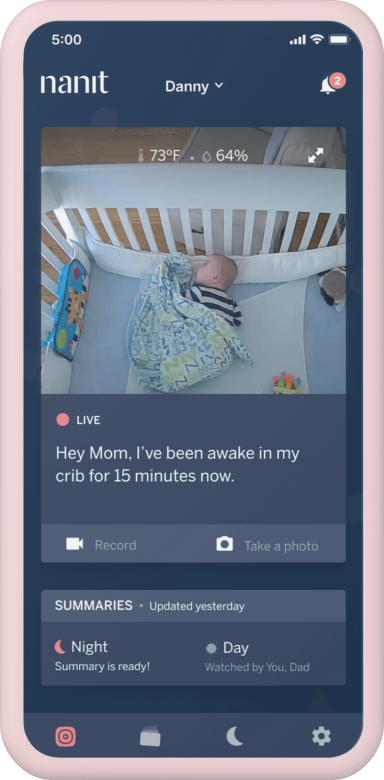The Problem
Babies don't sleep and we don't know why.
The Challenge
Transform a vast amount of data to easily digestible information with a delightful user experience.





Our Process
Design sprint and user testing
We started the project with a five day on-site workshop where we created a "Shared Brain" with the Nanit team, establishing business objectives and defining the product together through stakeholder interviews, rapid prototyping and user-testing.

Valuable insights
Our collaborative design process with the Nanit team and three rounds of user-testing with new parents allowed us to gain valuable insights about user needs and preferences.

Friendly, bite-sized information
The camera outputs a lot of data that could be rendered useless without proper presentation. The goal was to present it summarized in small chunks.
Raising babies is a team effort
Mom and dad are a team, perhaps with other team members alongside grandparents, nannies, older siblings etc that care about different content at different times. Nevertheless, the end goal is the same: to raise a healthy, happy baby.


Detailed night report
Sometimes you want to know even more. We made it easy for parents to analyze their baby's night with a segmented report covering several most important factors that impact quality of sleep.
Night Summaries
Every morning the app generates a night summary of short video snippets and a condensed sleep graph for the user.
Visual language
Every part of the app feels consistent with Nanit brand guidelines. Rounded geometric shapes in combination with subtle but vibrant color palette achieve an approachable, warm and human feel.
To make the whole experience seamless across multiple platforms, most of the UI components were custom designed, slightly different from the platform's design guidelines.
From a computer science perspective, Nanit is touting a rather impressive consumer application of machine learning. The number of variables in most spaces would make behavioral analysis nearly impossible. Fortunately for the Nanit team, almost all crib mattresses are the same size. This allows for the camera's parameters to be standardized so that the computer can break up the space into small bits that can be accurately analyzed.
The aesthetically sleek looking camera has been uniquely designed to track and analyze a baby's sleep patterns using smart algorithms while incorporating the highest safety standards. The camera goes beyond mere baby surveillance by creating benchmarks, counting sleep interruptions and contextualizing milestones in individual sleep environments to show not just whether the baby is sleeping, but how well.
Computer vision and parenting are two things that normally don't go together, but Nanit is a smart baby camera that combines them. The camera watches your baby sleep, giving you not only an eye into the crib, but also data about how your baby sleeps. It tracks things like how long it takes your infant to fall back asleep and provides a heat map of where in the crib they love to sleep.
The Nanit camera captures video footage of your child from a tall, white stand that hides its power cord and leans against the wall. Its fall-resistant design is made to thwart grabby babies, and it has a built-in nightlight on its ceiling-facing top side. (If the stand doesn't work for your nursery, you can also use Nanit on a tabletop.) But Nanit's most differentiating features work on the backend as its algorithms analyze everything the camera sees.
- Forbes
- TechCrunch
- The Verge
- Business Insider
Have a baby on the way?
Get Nanit and let us know what you think
 is now
is now 








